How to Read a Mold Swab Report
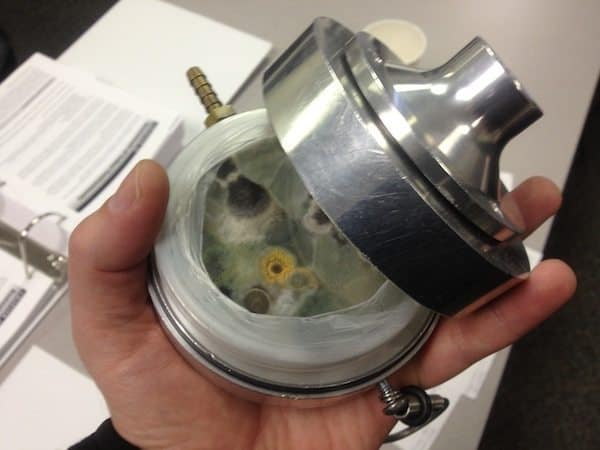
Mold Testing Air Quality Lab Estimation
People with asthma and mold allergies are the kickoff to ask about mold testing. Since their symptoms are primarily respiratory, information technology is only logical they ask for "air quality testing." Other individuals looking for peace of mind or suffering much more astringent symptoms sometimes as well ask for mold testing air quality services. This blog is about air quality testing and some of the variables and limitations that should be considered in every mold testing chore.
Part of our task is to help develop a mold testing air quality sampling programme specific to your project, and to assistance translate the lab results in light of discoveries fabricated during the visual inspection. I've heard mold testing described as "an art and a scientific discipline," and I agree with that sentiment. Since information technology's not a federally regulated contaminant information technology has been a niggling bit of the wild west in terms of who tests, what they exam for, and how the results are interpreted. For a customer – that should scare y'all! – because information technology has meant that anyone could call themselves mold inspectors without having adequate training or professional credentials to demonstrate their competence.
Mold Testing – When to Exam Air Quality?
Well-nigh experts, including the EPA and California Department of Public Health, suggest merely testing under very specific conditions. In general, a moisture and mold inspection past a qualified professional is far more useful in determining if a mold problem exists. Nevertheless, there are some circumstances that warrant boosted air quality testing. The most ordinarily referred to guidance for how to perform mold inspections and when/how to test for mold is the AIHA "Light-green Book," Recognition, Evaluation and Command of Indoor Mold.

Mold Testing AIHA Greenish Book
Here are three full general reasons that justify mold testing:
ane) Determining the scope of contamination.
2) Make up one's mind the type of contamination.
3) Clearance testing.
Mold Testing – What Type of Air Quality Testing Method?
If mold testing is pursued, these are the three most common types of samples collected:
- Air sampling: the most common form of sampling to appraise the level of mold. Sampling of the inside and outdoor air is conducted and the results to the level of mold spores inside the bounds and outside are compared. Oftentimes, air sampling volition provide positive identification of the beingness of non-visible mold.
- Surface samples: sampling the amount of mold spores deposited on indoor surfaces (tape, and dust samples). Dr. Ritchie Shoemaker, MD is a potent laic in dust sampling using the Ecology Relative Moldiness Index (ERMI).
- Bulk samples: the removal of materials from the contaminated surface area to identify and decide the concentration of mold in the sample.
In this weblog, we focus on air quality testing. In that location are 4 ways of air quality testing for mold:
- Spore trap non-feasible (non-culturable) sampling. While controversial, this is the most common blazon of "mold testing" we come across performed in the manufacture. A calibrated pump draws a known book of air over a greased slide. This is an "impaction" method of collecting spores. Based on a directly microscopic examination of a portion of the slide, the lab extrapolates how many spores are nowadays per cubic meter, and tin can identify many common genera of mold. One weakness of direct visual examination is that some mutual genera, such as Penicillium and Aspergillus, cannot exist differentiated and reported cumulatively. Another obvious weakness is that heavier spores, such as Stachybotrys, may be present merely non aerosolized and therefore underreported if but air sampling is performed.

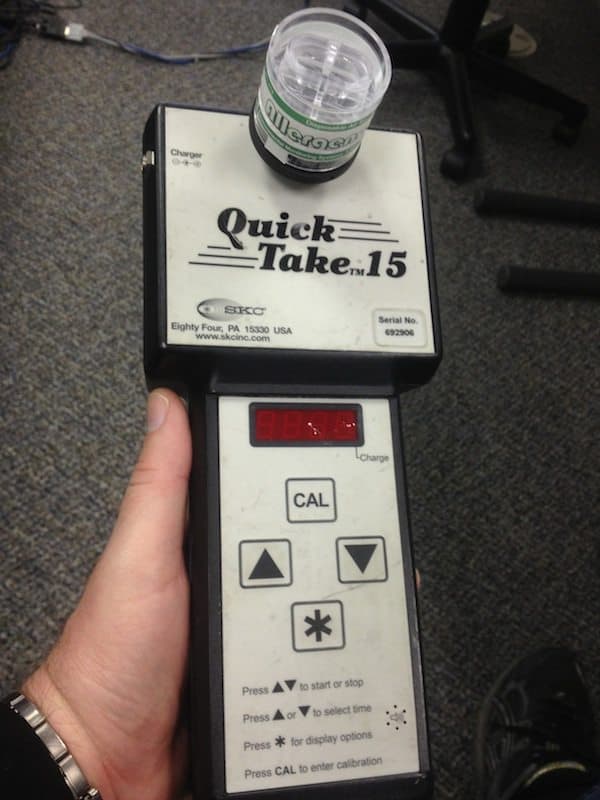 Mold Testing Air Quality Testing – Alex Stadtner using pump and Sporetrap
Mold Testing Air Quality Testing – Alex Stadtner using pump and Sporetrap - Pitri Dish-style, viable (culturable) sampling. The 2nd nigh common type of air sampling for mold is also an impaction-style collector. A petri dish with a growing media is placed beneath a pin-holed cap and air is drawn over the petri-dish. The petri-dish is then incubated and visually inspected then the number of colony forming units (CFUs) of different types of molds are identified and counted. Mutual types of mold growth media are Malt Excerpt Agar (MEA), Tater Dextrose Agar (PDA), and Hay Infusion Agar. A strength of this method is that molds tin be especiated. So in addition to differentiating between genera like Penicillium and Aspergillus, using viable (culturable) analysis you can identify if the mold is Aspergillus niger, or Penicillium marneffei. This can be valuable information since in that location are hundreds of species inside each genera, and some are more toxigenic than others. Some weakness of this sampling method include the fact that different molds prefer different growth media, temperatures and wet levels, but the lab will just use a "standard setting" unless instructed otherwise. So to go a more complete picture of the viable airborne spores in one space you may need to collect numerous petri-dish samples using different agars and to be incubated under dissimilar growing conditions. Some molds grow well nether lab conditions, and others don't. Some molds produce powerful chemical weapons used against neighboring colonies, which can influence the number of CFUs counted for both species.

Mold Testing Petri Dish Impactor
- Microbial Volatile Organic Compound (MVOC) sampling. When molds are wet and have food they grow. When mold is "eating" it produces metabolic byproduct gases known as MVOCs. Air samples tin either exist nerveless in a summa canister or sorbent tube, and the lab analyzes the air sample for a limited prepare of microbial VOCs. MVOC indicator gases include but are not limited to the following: Furan, ane- and 2-Pentanol, 2-Hexanone, two-Heptanone, 1- and 3-Octanol, and Geosmin. Most MVOC scans are limited in that they do not analyze for every possible MVOC, and most MVOCs have not been directly tied to a single species of mold and then extrapolating from just MVOC information is rather limiting. If you lot smell "musty" odors you are probably inhaling MVOCs. It's a sign of active microbial growth and can be tested via air sampling.
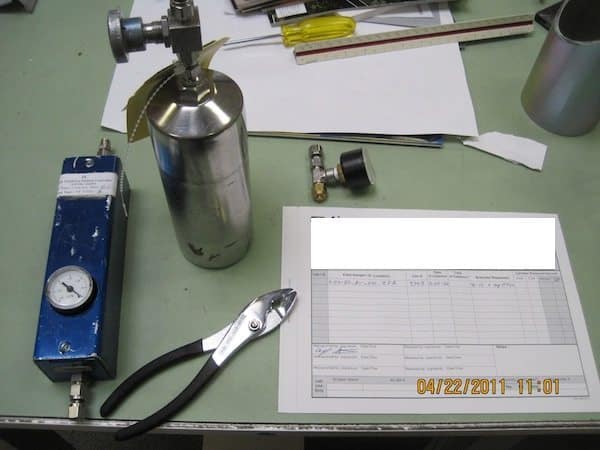
MVOC Testing for Mold
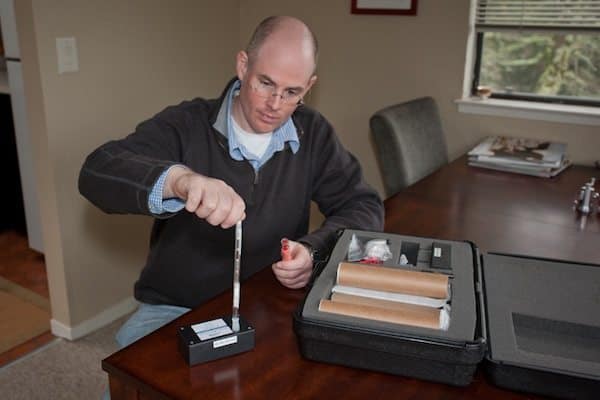
MVOC Mold Testing with Sorbent Tube or Summa Canister
- Mycotoxin Testing. Mycotoxins are secondary metabolites produced by fungi. These are basically cocky-produced chemical weapons wich can harm other fungus, and tin can likewise cause affliction and death in humans. Although the primary concern for humans is for ingestion, inhalation is besides of business concern. Few indoor ecology consultants are currently testing for mycotoxins. The iii almost commonly analyzed mycotoxins include aflatoxin, trichothecenes, and ochratoxin. The lab utilizes polymerase chain reaction (Mainland china) analysis to place and quantify mycotoxins in air samples. Samples are collected in 37mm cassettes, preloaded with 0.45 um pore-sized filters, and sampling times are longer than typical sporetrap grab samples. Whereas the to a higher place referenced types of lab analysis rely on a lab technician'southward power to visually identify and count… PCR has over a 95% conviction charge per unit and is more automated.
Mold Testing – How to Interpret Lab Results and Air Quality Data?
So you've had an inspection and received the lab results… what does it all hateful? Companies that but send convoluted lab reports without farther caption should exist put out of business. Information technology is the role of the Certified Indoor Ecology Professional to assistance interpret the lab results in combination with what was gleaned from the visual inspection.
Sporetrap lab results should include, at the VERY minimum, one outdoor sample and a handful of indoor samples. The outdoor sample is used as a command to compare to the indoor samples. Considering there tin be such variation in sporetrap samples the statistical significance from collecting and then few samples is very limited. Most labs simply share a chart showing how many of which type of genera were present.
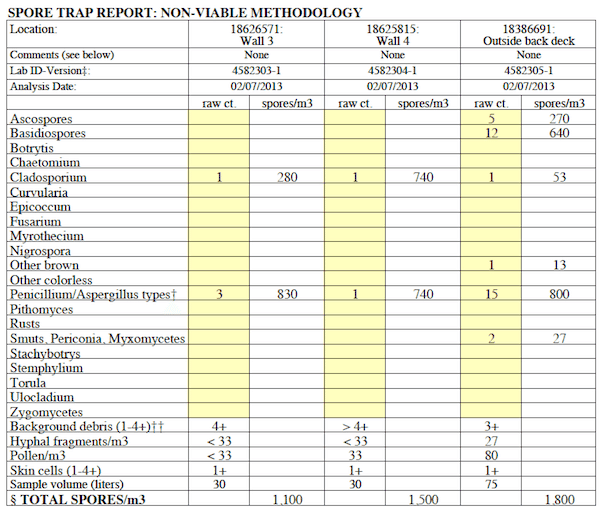
Sporetrap Chart – Mold Testing Not-Viable, Non-Culturable
Some labs offer their own "limited interpretation," such equally the MoldScore from EMLab P&Thousand. "MoldSCORE™ is a specialized method for examining air sampling data. It is a score between 100 and 300, with 100 indicating a greater likelihood that the airborne indoor spores originated from the outside, and 300 indicating a greater likelihood that they originated from an inside source…" Below y'all can see some obvious "spikes" that EMLab identified as statistically significant college counts of Cladosporium and Pen/Asp indoors compared to outdoors.
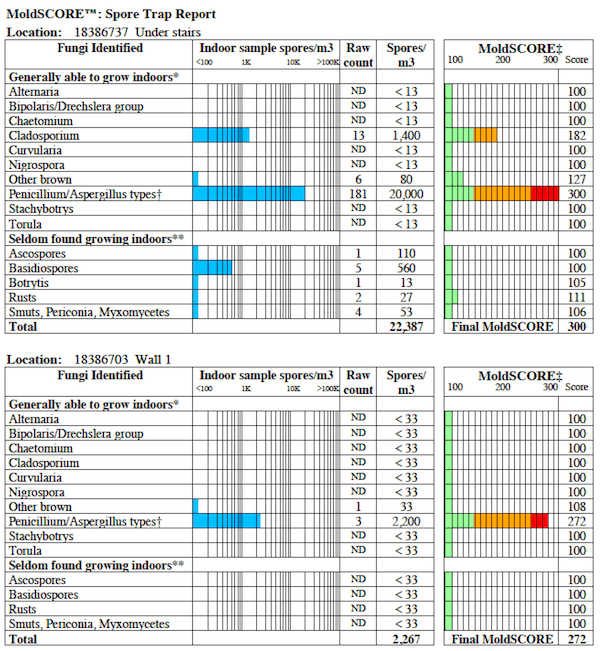
Mold Testing Lab Estimation
Some Building Biologists refer back to the Salubrious Home Standard for guidance on interpreting sporetrap results:

Building Biology Sporetrap Estimation Method
Viable (Culturable) results are usually presented in CFU'southward, and different labs apply different set points to determine low, medium or high probability of significant mold growth. Building Biologists oft refer to the Healthy Home Standard suggested interpretation guidelines:
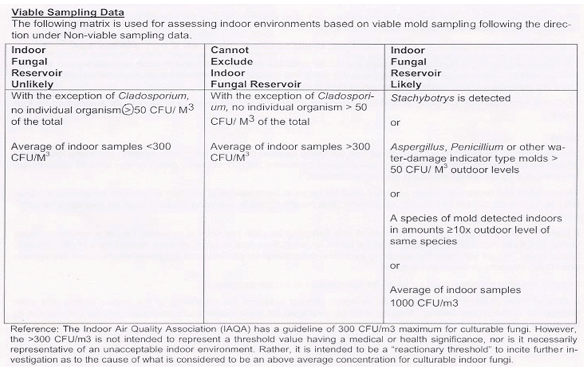
Building Biology Viable Culturable Lab Interpretation
There is much less standardization for interpreting these concluding two sample types. MVOC results may come with lab interpretation such as this: "Levels below 8 ng/L are typical for most homes and should not crusade great business organisation for healthy individuals. Levels between 8 and 30 ng/L point a depression level of mold which, generally, affects people who are sensitive to molds. Levels in a higher place 150 ng/50 bespeak that a high level of active mold growth is present and it is likely that nearly all occupants of the habitation will be affected."
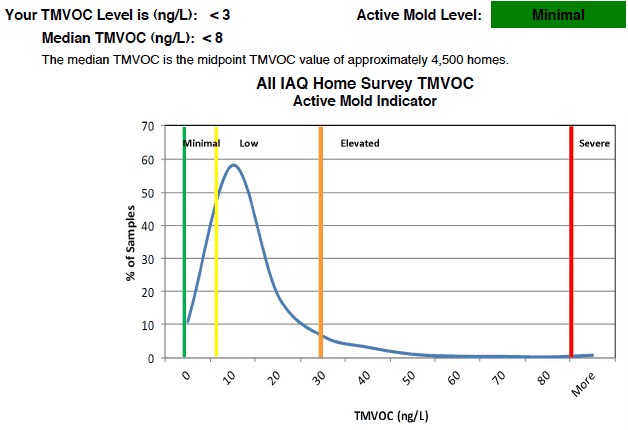
Microbial VOC (MVOC) Lab Analysis
Mycotoxin results may be paired with an individual'south blood test results, if they are working with an ecology medico. We are frequently called in as a outcome of an environmental medicine practitioner finding that an individual's body is reacting to mycotoxins… and and so nosotros have to find where that exposure is occurring – usually at home or work.
1) Decide if ecology sampling would add value to the case, two) ascertain a sampling plan that would answer a question or prove/disprove a hypothesis, 3) perform testing in accordance with industry guidelines, 4) only use qualified laboratories with good rail records and the advisable certifications, 5) interpret data in combination with information collected during the inspection, 6) provide the estimation in a user-friendly fashion written to the "correct audition."
Until mold testing becomes more regulated it volition remain "an art and a science."
Healthy Building Scientific discipline is an ecology consulting business firm which provides mold testing and mold inspection services for commercial, residential, multi-family unit, buildings, offices, industrial and manufacturing workplaces, hospitals and medical facilities, and unmarried-family homes in the greater San Francisco Bay Area and all of Northern California including the cities of San Francisco, San Jose, Oakland, and Sacramento.
Source: https://healthybuildingscience.com/2013/02/14/mold-testing-air-quality/